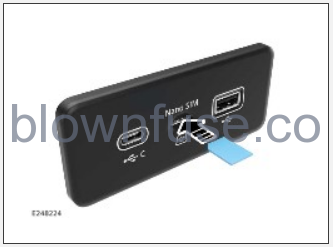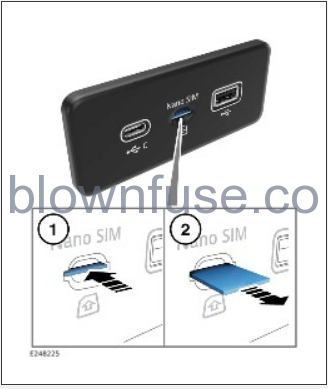 2023 Land Rover Defender Connectivity
2023 Land Rover Defender Connectivity
CONNECTIVITY OVERVIEW
The connectivity menu options may vary depending on the market and specification of the vehicle.
The connectivity menu allows the user to connect a phone or audio device to the vehicle. The user can also connect the vehicle to the internet.
Internet connectivity requires either a data-enabled embedded SIM card, a data-enabled nano SIM card, or an in-range external Wi-Fi network.
Only telematics features and software updates work over an external Wi-Fi network. Infotainment features do not operate over an external Wi-Fi network.
The following methods allow for phone, audio, and internet connectivity:
- Bluetooth: Allows for pairing a device for phone and audio. See PAIRING AND CONNECTING USING THE PHONE and CONNECTING A MEDIA DEVICE.
- Mobile Data: Allows for the vehicle to connect to the internet via a mobile network, using a data-enabled nano SIM card, or a data-enabled embedded SIM card. See MOBILE DATA CONNECTIVITY.
- Hotspot: Creates a Wi-Fi hotspot in the vehicle, to allow internet connection of Wi-Fi equipped devices, e.g., a tablet, laptop, or a smartphone. Also allows sharing of media between the Wi-Fi equipped devices inside the vehicle. See HOTSPOT.
- Wi-Fi: Allows for the vehicle to connect to the internet using an external Wi-Fi network. See WI-FI CONNECTIVITY.
The availability of Mobile Data, Hotspot, and Wi-Fi depends on the market and specification of the vehicle.
Connectivity for Online Pack with Data Plan and Wi-Fi Enabled with Data Plan is provided by a third party provider. For more information go to: www.landrover.com/pivi-pro-terms.
MOBILE DATA CONNECTIVITY
Make sure the relevant safety warnings and cautions for touchscreen operation have been read and understood before using the touchscreen. See TOUCHSCREEN SAFETY.
Connected vehicles with no SIM card slot in the media hub have an embedded SIM card.
Mobile data requires a vehicle with a data-enabled embedded SIM card, or the installation of a data-enabled nano SIM card. See FITTING A SIM CARD.
To enable Mobile Data:
- Touch the settings icon from any screen. See SYSTEM SETTINGS.
- Select Connectivity.
- Touch the Mobile Data toggle to switch on or off.
- When displayed, select Agree to agree to the terms and conditions.
Vehicles that use a nano SIM card for connected services can edit mobile data settings.
To display and edit the mobile data settings:
- Touch the settings icon from any screen. See SYSTEM SETTINGS.
- Select Connectivity.
- Touch Mobile Data.
The Mobile Data menu displays the following:
Network Provider: The network provider of the vehicle’s SIM card is displayed. To change the network provider settings:
- Set Auto Select to Off.
- Select Manual Network Selection.
- Add the Network, Username and Password.
- Select Connect.
Roaming: Data roaming is set to Off as default. Select On to enable roaming.
Usage Limit: The usage limit is set to Off as default. Select On to enable usage limit.
Usage: The usage counter displays the total data usage for the month. The usage counter resets on the 1st day of the month, as default. When the usage limit is set to On, the usage limit also displays. Select Usage to change the usage limit and the monthly reset date. Use the reset counter to reset the current usage to zero.
SIM LOCK: A PIN can be set or changed for a vehicle with an inserted nano SIM card.
Remember SIM PIN:
- Select On to enter a SIM Lock PIN. The PIN is required each time mobile data is on.
- Select Off to forget the PIN.
HOTSPOT
Make sure the relevant safety warnings and cautions for touchscreen operation have been read and understood before using the touchscreen. See TOUCHSCREEN SAFETY.
The availability of Hotspot depends on the market and the specification of the vehicle.
The Hotspot feature requires a data-enabled embedded SIM card.
Cellular connectivity cannot be guaranteed in all locations.
The Hotspot feature provides in-vehicle access to cellular internet, enabling wireless devices to be used in the vehicle. For details of the Fair Usage Policy associated with the Hotspot feature, please refer to the Land Rover website: www.landrover.com/pivi-pro-terms.
To enable Hotspot:
- Touch the settings icon from any screen. See SYSTEM SETTINGS.
- Select Connectivity.
- Hotspot: Touch to switch the toggle on or off.
To display and edit Hotspot settings:
- Touch the settings icon from any screen. See SYSTEM SETTINGS.
- Select Connectivity.
- Touch Hotspot.
The Hotspot menu displays the vehicle’s Wi-Fi hotspot name, password, and frequency. The Hotspot name is computer generated by the vehicle and cannot be changed.
To enter a new password, touch the chevron next to the displayed password. Land Rover password strength standards will apply.
To connect a device to the vehicle’s Hotspot, switch the device’s Wi-Fi to ON. Select the vehicle’s Hotspot name on the device. Insert the password.
Some devices cannot receive 5GHz signals. To change the signal frequency between 2.4 and 5 GHz, use the selection buttons underneath the frequency header.
WI-FI CONNECTIVITY
Make sure the relevant safety warnings and cautions for touchscreen operation have been read and understood before using the touchscreen. See TOUCHSCREEN SAFETY.
Wi-Fi allows for the vehicle to connect to the internet using an external Wi-Fi network.
To enable Wi-Fi:
- Touch the settings icon from any screen. See SYSTEM SETTINGS.
- Select Connectivity.
- Wi-Fi: Touch to switch the toggle on or off.
To display and edit Wi-Fi settings:
- Touch the settings icon from any screen. See SYSTEM SETTINGS.
- Select Connectivity.
- Touch Wi-Fi.
The Wi-Fi menu displays any Wi-Fi networks in range.
To connect to an unknown network, select the network name. If the Wi-Fi network is password protected, a keyboard displays to allow entry of the password.
To connect to a known network, select the network from the list of known networks.
The vehicle will automatically connect to a known network with the best signal strength.
To connect to a hidden network:
- Select Add network from the network list.
- Enter the Network name.
- Enter the Security type.
- Enter the Password.
- Select Connect.
ABOUT CONNECTIVITY
About Connectivity displays information about the vehicles connections. The menu displays the vehicle’s MAC Address, IMEI, ICCID, IMSI, MNO and APN.
Select Reset Connectivity to remove saved networks and restore default functionality.
CONNECTIVITY STATUS ICONS
Depending on the network connectivity, some features and services, including Wi-Fi, may not operate as expected, or at all. A strong 3G and 4G connection is required.
The following icons display the type of cellular and Wi-Fi connections:
Connecting.
E (edge) mobile network connectivity.
2G mobile network connectivity.
3G mobile network connectivity.
4G mobile network connectivity.
No mobile network connection.
Internet roaming.
When the vehicle is connected to an external hotspot, a Wi-Fi icon is displayed instead of a cellular icon.
The following icons display when software updates are available:
A software download is available.
To schedule a software download.
An important software download is required.
FITTING A SIM CARD
Make sure the nano SIM card is located correctly into the card holder. Failure to do so may damage the SIM card or SIM card reader.
The availability of the nano SIM card slot is dependent on the specification and market of the vehicle.
Some network operators may lock SIM cards to operate in specific devices only. Contact the network operator if the SIM card requires unlocking.
A nano SIM card must be inserted into the SIM card holder. The SIM card reader utilises a SIM interface. If the SIM card is a different size, e.g., a micro SIM, a replacement SIM card is required.
The SIM card reader slot is located in the centre console’s cubby box. See AUXILIARY POWER SOCKETS.

To fit a nano SIM card, insert the card with the contacts facing down and the shortest end facing in. The card should not be protruding once correctly inserted.
Push the nano SIM card 2 mm further into the slot to firmly engage the latch.
Once the nano SIM card is fitted, enable mobile data connectivity. See MOBILE DATA CONNECTIVITY.

To remove a nano SIM card, gently push in (1) and release (2).
SOFTWARE UPDATES
In certain cases, the vehicle informs the user before an update, and outlines any preconditions the user must follow to make sure vehicle operation following the update. These can include requirements to drive the vehicle shortly after an update has been applied.
The vehicle may support the download and installation of over-the-air software updates. Over-the-air software allows certain components of the vehicle to be kept up to date without the need to visit a retailer/authorised repairer.
The ability to perform an update is simple and intuitive from within the vehicle’s infotainment system.
When a new software update is available, and depending on internet connectivity, the vehicle automatically begins the download process with no interruption to the vehicle usage. On completion of the download, a notification displays on the touchscreen asking to begin the installation process.
Depending on the specification of the vehicle, software downloads may be requested to be done manually.
Follow the on-screen prompt to start the installation process or schedule for a preferred time. A preferred time can be set via Vehicle and Software Updates menus in the touchscreen. See SYSTEM SETTINGS.
During installation the user can access the vehicle at any time, but it will not be possible to start the vehicle.
Upon successful completion of the update, an on-screen notification is displayed. Following the update, the current software version information is visible within the vehicle’s infotainment system.
An update process can take up to an hour to complete.
To complete a software update observe the following conditions:
- The vehicle has to be locked and alarmed to start the installation process.
NOTES
Once the installation is initiated, the vehicle may still be accessed, however it will not be possible to start the vehicle. - The vehicle has to be parked and stationary.
- The new software must be successfully downloaded to the vehicle.
- The vehicle needs cellular or Wi-Fi connectivity during the process of performing a software update. See CONNECTIVITY OVERVIEW.
- The terms and conditions for the installation must be accepted.
- The vehicle update must not be interrupted, either by the vehicle owner or by loss of internet connectivity.
- The hazard warning lights, SOS emergency call, Optimised Land Rover Assistance call, or Secure Tracker must not be active.
- The vehicle may need to be associated to an active InControl account. See INCONTROL ACCOUNT SET UP.
Availability of over-the-air updates may vary, depending on the market and vehicle specification. For further information go to: www.landrover.com/pivi-pro-terms.

